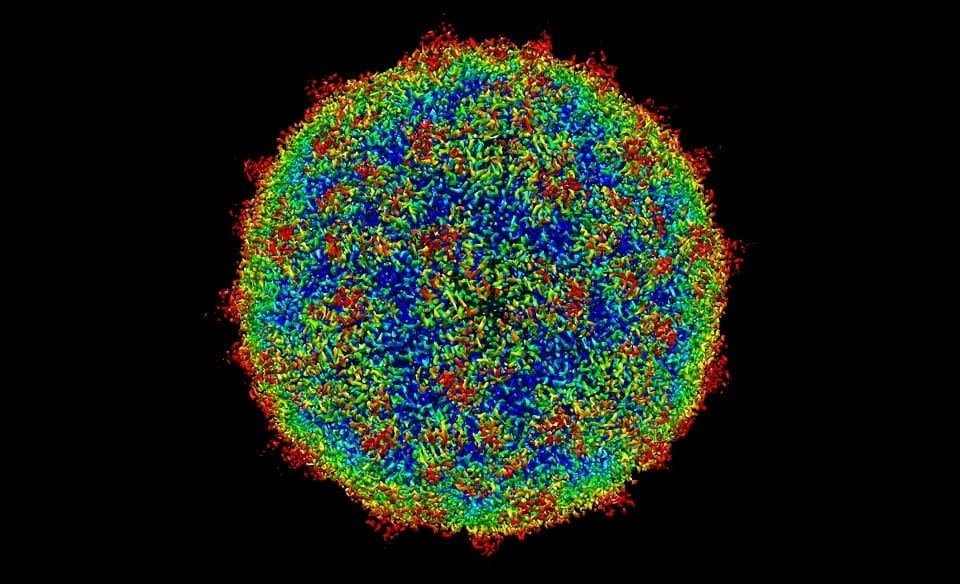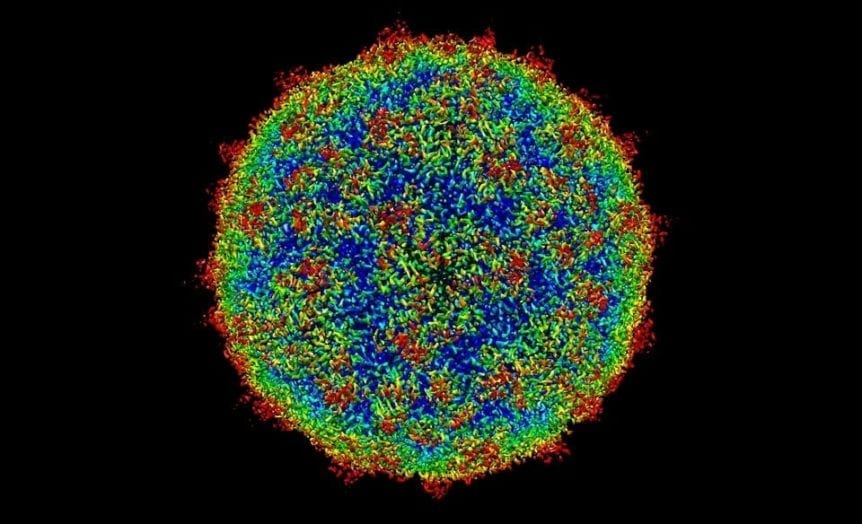The common cold is the leading cause of doctor visits in the United States. Of the billion colds that the U.S. population contracts each year, more than 80% affect school-aged
children. This article focuses on the role zinc has in the treatment or prevention of the common cold with emphasis on the superior results from PERQUE Zinc and Throat Guard Lozenges and PERQUE Energized Double Zinc Guard tabsules.
Viral nasopharyngitis is the technical term for the common cold and can be caused by more than 100 different viruses of which rhinoviruses and corona viruses are the most common.
Rhinovirus

Although the symptoms of a ‘cold’ are generally benign, cold viruses are the most infectious. Adults on an average get about 2-4 colds a year and children 6-10 depending on their age and exposure. Colds account for 189 million lost school days and about 126 million missed workdays by parents who stay at home to take care of their sick children.(1) This shows how common are marginal or deficient zinc levels. People with healthy zinc (and other essential nutritives) rarely (if ever) are hospitable to these almost ubiquitous viral exposures.
The “cold” season
People are most likely to have colds during fall and winter, starting in fall through spring. The increased incidence of colds may be attributed to the fact that more people are indoors and close to each other. In addition, many cold viruses thrive in low humidity, making the nasal passages drier and more vulnerable to infection. All of these stresses also increase zinc requirement for exposed people (almost all of us).
Key symptoms of the “common cold”
Each individual experiences symptoms differently. Symptoms of the common cold include:
• stuffy, runny nose
• scratchy, tickly throat
• sneezing
• watering eyes
• low-grade fever
• sore throat
• mild hacking cough
• achy muscles and bones
• headache
• mild fatigue
• chills
• watery discharge from nose that thickens and turns yellow or green
Treatment modalities for the “common cold”
Conventional therapies for colds and flus focus primarily on temporary symptom relief and include over-the-counter antipyretics, anti-inflammatories, and decongestants. On the other hand, nutrients like vitamin C and zinc have been extensively studied for their beneficial role in treating colds.
What is zinc?
The FNB of the NRC/NAS1 established zinc as an essential mineral in our diet in 1974. It is required by hundreds of cell enzymes for their normal catalytic functions and required.
1 Food and Nutrition Board of the National Research Council of the National Academy of Sciences for the action of insulin in the body. Zinc has a critical role in maintaining healthy
immune, hormonal, neurochemical, and digestive functions.
Zinc and the “common cold”
Many clinical studies have evaluated the usefulness of zinc in treating the common cold, including zinc lozenges, nasal sprays, or nasal gels.(2) In a recent study of 150 children, zinc was found to be effective in decreasing the severity of cold symptoms. (3) Therapy with zinc gluconate glycine lozenges has shown to significantly reduce cold duration and antibiotic use in school-aged children. Prophylactic usage of zinc can also significantly decrease cold frequency.(4) The correct amount and form of zinc for maximum effectiveness is key. Inattention to this aspect in certain studies have resulted in inconclusive and inconsistent results.(5)
How does zinc work?
Zinc works in several possible ways:
• Prevents the formation of proteins that are needed by a cold virus to reproduce itself and increase. Without viral duplication, the cold symptoms will cease.
• Attaches to proteins located on the edge of a cold virus. This attachment impairs the ability of the virus to enter the body’s cells, notably those in the respiratory system (the nose, throat, and lungs).
• Finally, it protects and stabilizes the lining of the cells, which also reduces the chance that the virus will penetrate the cells.
PERQUE Zinc and Throat Guard Lozenges provide 15 mg. of zinc in one lozenge in the unique mixed citrate, aspartate and glycinate forms for maximum function and bioavailability. The presence of botanicals like Echinacea(6), Slippery Elm, and the flavanol OPC provide additional synergists. For those who have more therapeutic needs, PERQUE Energized Double Zinc Guard is also available with 25 mg. of zinc in each tabsule.
For ultimate year-round protection, especially during the cold season, add PERQUE Potent C Guard and PERQUE Repair Guard to your regimen.
References
1. Roxas M, Jurenka J. Colds and influenza: a review of diagnosis and conventional, botanical, and nutritional considerations. Altern Med Rev. 2007 Mar;12(1):25-48.
2. Caruso TJ, Prober CG, Gwaltney JM Jr. Treatment of naturally acquired common colds with zinc: a structured review.Clin Infect Dis. 2007 Sep 1;45(5):569-574. Epub 2007 Jul 20.
3. Kurugöl Z, Bayram N, Atik T. Effect of zinc sulfate on common cold in children: Randomized, double blind study.Pediatr Int. 2007 Dec;49(6):842-847.
4. McElroy BH, Miller SP.Effectiveness of zinc gluconate glycine lozenges (Cold-Eeze) against the common cold in school-aged subjects: a retrospective chart review. Am J Ther. 2002 Nov-
Dec;9(6):472-475
5. Eby GA. Zinc ion availability – the determinant of efficacy in zinc lozenge treatment of common colds. J Antimicrob Chemother 1997;40:483-493.
6. Shah SA, Sander S, White CM, Rinaldi M, Coleman CI. Evaluation of echinacea for the prevention and treatment of the common cold: a meta-analysis. Lancet Infect Dis. 2007 Jul;7(7):473-480.
7. PERQUE Double Zinc Bioavailability Study 1990: Refer to PERQUE Double Zinc Guard product sheet.
Call PERQUE at 800-525-7372 for further information or visit www.PERQUE.com
Did you enjoy this post? We post new content regularly! Click here to see our latest blog posts.


